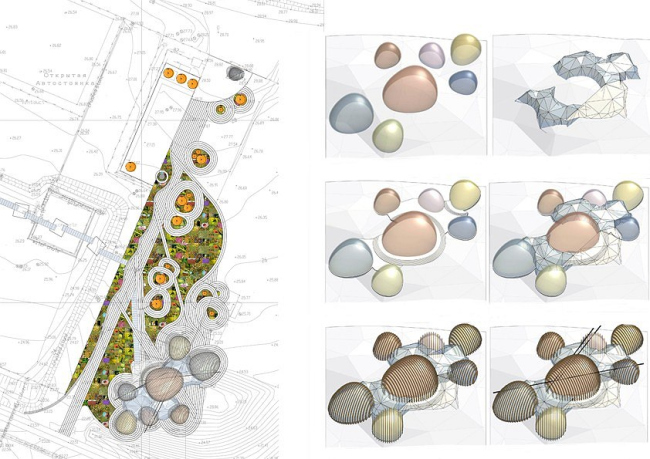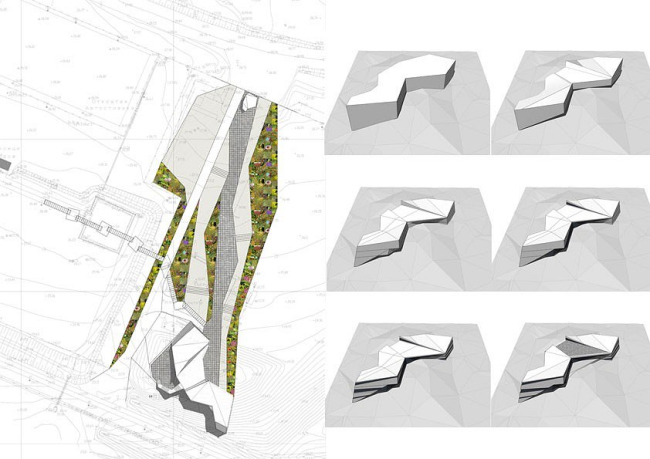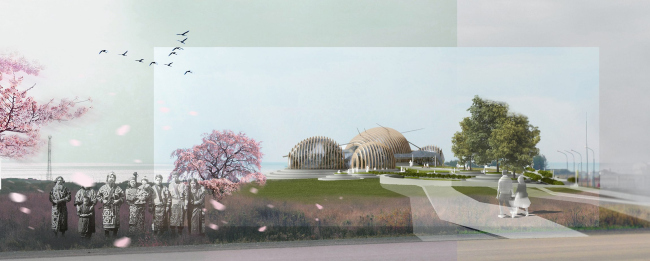|
Architectural office "ABV Group" won the contest for the development of the concept of a multifunction public center on Sakhalin Island. The two design solutions of the complex were executed by six young architects of this studio.
Working on
such a unique place as Sakhalin became an
exciting as well as educational experience for "ABV Group". It was
not only the location that attracted the architects, though, but its functional
purpose as well: in fact what the architects were to do was to design some sort
of “all-purpose complex meant for various kinds of leisure as well as cultural
and instructional activities for its visitors”. Of course, such expressions can
be traced back to the vocabulary of the constructivists of the 20's of the
previous century but, as the architects themselves share, it was exciting for
them to feel part of this great tradition and take it to a new level in
accordance with the needs of today.
The key role in shaping the form of the future complex was played by the island
itself, the unique place where people for centuries have lived at one with the
nature. Because the project was actually a competitive bid, "ABV
Group" from the very start decided to come up with two solutions, as
different as possible. One of them, the one that was ultimately picked by the
commissioner, was based on the image of terrain that is characteristic for Sakhalin - low-rise mountain ranges, assemblages of bare
rocks and shears of fibrous washed-out soil. According to the authors
themselves, the general layout of the complex looks a lot like a lizard that is
basking in the sun on a hilltop. The project also provides for the climatic
situation of this area - Sakhalin is rather
hot in summer, and it is rather cold in the usually snowy winter - as well as
for the issues of seismic safety of the future complex. It is this particular
circumstance that predominantly conditioned the compositional solution: the
building is designed as a two-floor affair and it has a three-part structure. The
cinema hall, the exhibition all, the meeting rooms, the computer class, and the
earthquake shelter - all are freely scattered over the cells of the roughly
drawn layout.
The main volume is placed on the hilltop; it has a flat functional roof that is
designed as a spacious sightseeing platform that commands a fine ocean view. This
platform is accessible via a stairway that, from a bird's height view, looks a
lot like a lizard's paw. The other parts of the sharp-angled volume are covered
with pitched roofs and cascade down the slope of the hill making the building
look like a mountain ridge. This impression is enhanced by the window bands
that dissect the concrete surface of the wall at different angles; the volume,
however does not completely fade into the landscape thanks to its facades
decorated with bright patterns that echoes the motifs of the national costume
of the Aines - the people that once populated this part of Sakhalin.
And, while in this project solution the architects created a single structure,
in the second options each of the functional zones gets a volume of its own,
these volumes united by the glass space of the hall. In this particular case,
the authors also drew inspiration from the surrounding nature, not inland the
time, but at sea. The complex, assembled of volumes of various sizes and shapes,
looks like a group of islands, scattered over the boundless waters, or some
sort of pebbles that cover these shores in abundance. As was already mentioned,
the buildings are connected with a transparent structure: the glass structure
if the domes is supported by the wooden ribs of each volume's external skeleton
- the skeletons are movably fastened to the base, which makes the whole
structure earthquake-proof. None
None
None
None
None
None
None
None
None
None
None
|










